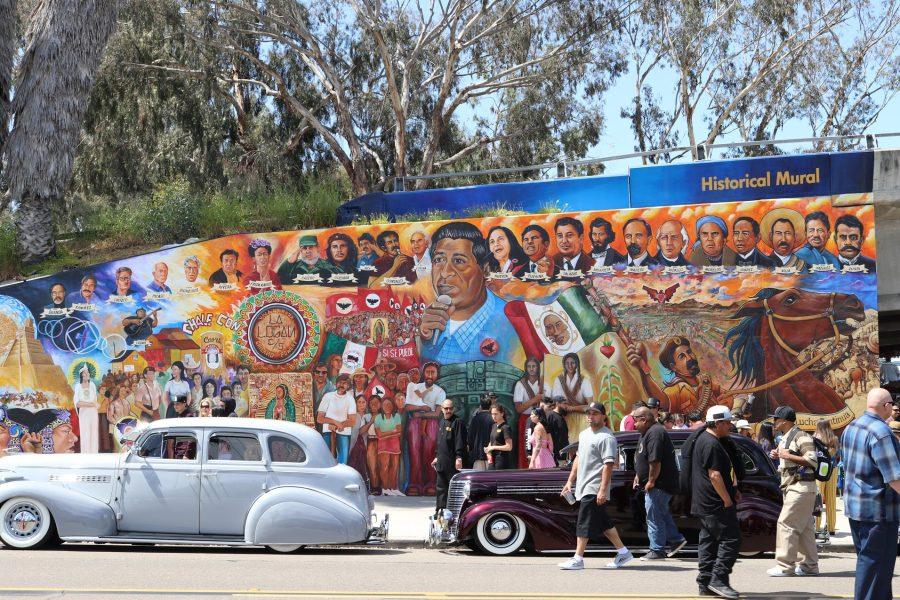The UC San Diego Library joined other Chicano activists and organizations at the 49th annual Chicano Park Day Celebration to celebrate the history of the park on April 20. Under the theme of “Danzantes, Protectors of Our Traditions and Chicano Park, 500 Years of Anti-Colonial Struggle,” the festival showcased the culture and traditions of the San Diego Chicano community.
The festival included music from several local bands, as well as dance performances from groups including the Ballet Folklórico Aztlán de California State University, Northridge, and the Danza Azteca / Calpulli Mexihca. Speakers representing the Brown Berets and Mujeres en Resistencia, two local Chicano political organizations, were also present.
According to the San Diego Union-Tribune, organizers of the event expected about 5,000 attendees. This number included Barrio Logan community members, Chicano activists and performers, and citizens from the greater San Diego area.
The UCSD Library was among the groups and organizations tabling at the event. Cristela Garcia-Spitz, a digital initiatives librarian at the UCSD Library, said that the library originally got involved with the Chicano Park Day Celebration five years ago in order to promote their newly digitized Chicano Studies collections.
“The [UCSD] Library received a National Historical Publications & Records Commission grant in 2012 to digitize the Herman Baca Papers, and we wanted to get the word out to the community and demo the website,” Garcia-Spitz told the UCSD Guardian. “Herman Baca, a Chicano rights activist from National City known for his community-based grassroots organizing, donated his archives to [UCSD] so that others might learn about the struggle for civil rights and political and judicial equality.”
Lynda Claassen, the director of special collections and studies at the UCSD Library, explained to the Guardian that the Chicano Studies collections have been utilized and developed further over the years.
“In addition to the extensive manuscript collections, … both Special Collections & Archives and the general circulating collection actively collect materials in support of Chicano Studies,” Claassen said. “Materials are incorporated into class assignments, and at least two UCSD dissertations have focused on the unique materials held in the Library.”
The theme of “Danzantes” refers to the Danza Azteca / Calpulli Mexhica, a local dance group originally created with the mission to “preserve and disseminate the ancestral values of the Chichimeca, Otomi, and Azteca call dance.” Tommie Camarillo, a chairperson for the Chicano Park Steering Committee, explained the historical significance of the dance group with Chicano Park.
“The reason we came up with the theme of the Danzantes is because they are always there when needed,” Camarillo said. “They were there guarding our Chicano Park Flag when the [racists] came to Chicano Park and the Danzantes gathered around our flag, and [they] blessed the park … its people, and the community.”
Chicano Park was originally created in 1970 after community members from Barrio Logan protested the construction of the San Diego-Coronado Bridge, which had been constructed a year prior and bisected the community. Local artists and activists soon began painting murals on the bridge supports dedicated to the community and Chicano culture, a practice which has continued to this day. Chicano Park was recently designated a National Historic Landmark in 2016.
Photos taken by Jacob Sutherland.









Annie R • Apr 24, 2019 at 7:52 am
It was much more than the construction of the SD-Coronado Bridge that led to the creation of Chicano Park. The start of construction of a California Highway Patrol station was the final straw that led to the takeover of Chicano Park land. This came was after the complete disregard for Logan Heights residents–rezoning the area to allow the influx of industry, junkyards, metal shops & other toxic businesses incompatible with a residential community, then the community was bisected by the construction of I-5 that displaced many lifelong residents, and then further destroying the neighborhood by the construction of the SD-Coronado Bridge. Occupying the land to halt the construction of the CHP station in April 1970 lasted 12 days. Finally an agreement was reached between the community and the city, which agreed to acquire the site from the state for the development of a community park.